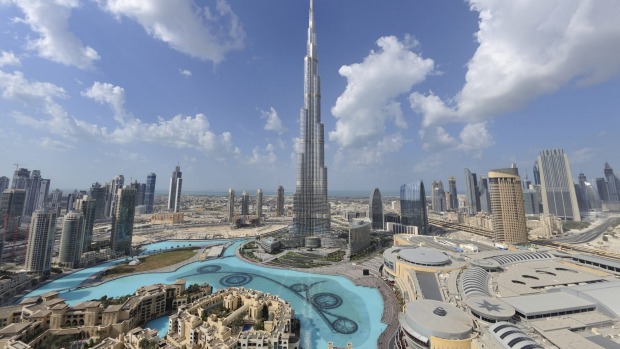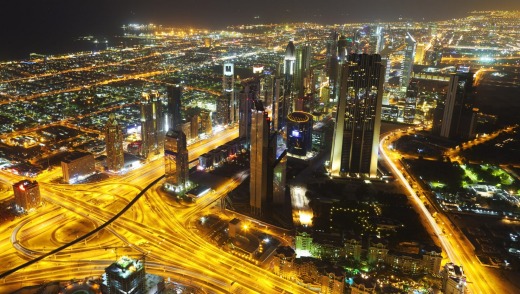
To arrive at the Dubai Mall in the weeks leading up to Christmas is to arrive at a humongous, perturbed ants' nest. Thousands of beings, many agitated, scurry hither and yon inspecting, shoving, panicking. Nothing is still. Everything is frantic.
The mall, the world's largest by some measurements, is now, by some other measurements, the planet's most visited destination. The figures include anyone who visits the mall, whether they are tourists or whether they live in Dubai, but, if the 75 million people who came here in 2013 had stayed, it'd be the world's 18th most populous nation.
While it is undeniably popular, if the mall is an ants' nest, then the Burj Khalifa, standing just outside, is the queen to which all drones feel drawn. Or perhaps not a queen, exactly – now five years old, the world's most spectacular, anatomically troubling phallic symbol doesn't look the least bit ladylike.

Long before it officially opened in 2010, the Burj was the world's tallest building, but then its whole raison d'etre was to stack up absurd and impressive-sounding statistics. Things like: at 828 metres tall it's roughly double the height of the Empire State Building (formerly the world's tallest building for almost 40 years); at its tip, there's a two-metre sway; if King Kong were up there, the dull noise coming from his chest-thumping would take more than two seconds to get to ground level; if your standard unit of measurement is elephant, you may find it useful to know that the material in the building weighs as much as 100,000 of them, three times more than the surviving wild population of the Asian species.
Here are some more facts about the Burj Khalifa: it was supposed to be called the Burj Dubai, but the city was on the brink of bankruptcy and got an 11th-hour, $US20 billion bailout from neighbouring Abu Dhabi and the name suddenly changed; the ruler of Abu Dhabi is called Sheikh Khalifa; the tower is not connected to the sewerage network, so all effluent is gathered and trucked out of town like Coca-Cola at Christmas; officially, one man died during its construction.
A man died. It's worth repeating – someone from somewhere lost a son or brother or maybe father. Some sources say he fell, some say he jumped. In either case, a human being was sacrificed to the great architecture gods in order that people could stand and stare at this colossus.
Except if it's true that only one worker died in the six years it took to build the Burj Khalifa, then it was a remarkably safe workplace. Scotland's iconic Forth Road Bridge claimed 78 lives during its construction in the late 1800s, which you might put down to Victorian disregard for manual labourers, but 90 years later, when New York's World Trade Centre was being erected, 60 lives were ended. The Sydney Harbour Bridge was comparatively safe, but it still claimed 16 souls. Uncomfortable a thought though it may be, you may have to accept that when people build these giant monuments, human lives become another cost much like bricks and mortar. Look on those works, ye mighty, and despair.
Spending a day at the base of the building doesn't suggest to me that many among the crowds think too much about the cost of construction. Ill-equipped with smartphones, great swathes of humans are bamboozled by their cameras' inability to squeeze all of the enormous structure into frame, even when they've got them dangling from the ends of selfie-sticks. They frown and try again. It is staggering to see how many believe that the miracle of Adrian Smith's design will be improved by the addition of their face.
Despite the sad selfie scene, I have to confess, I kind of love the Burj Khalifa. In the six years since I first visited in Dubai, I've never been able to pass without ogling it. You can judge the weather by how visible the tower is from anywhere in the city, and at New Year it is home to one of the world's best fireworks displays. It is, in more ways than one, a lightning rod, and I find it sort of magical, especially when the sun sets and the light gleams off it like some colossal tusk goring the heavens.
The interior is both sublime and ridiculous too. It is home to the world's first Armani Hotel, which also opened in 2010, ahead, even, of the Milanese mothership. Everything inside has been personally approved by Giorgio Armani so, perhaps unsurprisingly, much of it feels like a vast, slightly sterile suit. After a slow start, business is pretty good these days, with a range of restaurants finally winning critics over and an occupancy level that may even make it profitable. At New Year, when as many as 1.7 million people gather to see the Burj Khalifa's fireworks, the Armani Hotel offers front-row seats.
Of the 163 floors inside, the hotel takes up most of the bottom 39. Many of the rest are reserved for private residences and office buildings. It's hard to say how much of it is full, though the last official release said 80 per cent of the private residences were occupied (two-bedroom apartments start from about $7000 a month). The occupancy figures for office space are unknown, but are considerably lower.
But there are still all those records, like Atmosphere, on the 122nd, which remains the world's highest restaurant. The lift to get up to those floors is one of the world's fastest and travels the longest distance and, even though it blasts you with propaganda on the way up and down, it's hard not to be impressed. The thing about records, though, is that there's always someone looking to break them. The 76th floor had the world's highest swimming pool, until it was usurped by a Ritz-Carlton in Hong Kong, which built one on its 118th. It is, as they say, tough at the top.
Quite inexplicably, when it came to arranging a viewing deck inside the world's tallest building, no records were set, at least not initially. When the At the Top viewing deck opened with the rest of the building five years ago, it was not the world's highest, despite being situated 452 metres above the ground. It was obviously not at the top, either. This was the same kind of head-scratching oversight that resulted in the Burj Khalifa/Dubai Mall metro station being built, as though by accident, an entire kilometre away from either destination. Nonetheless, At the Top opened with great fanfare in 2010, only to close again within a few weeks. Officially there was a problem with lifts. The world's second-highest observation deck reopened a few months later and has been overwhelmingly popular ever since.
It took until October 2014 for the Burj Khalifa to finally break the record by opening At The Top Sky on the 148th floor. It's not really at the top either – that's still more than 250metres away – but I suppose you could say it genuinely is in the sky. And again, whatever cynicism I have for it and the shop "at the top" and the other shop at the bottom and its stupidly inaccurate name … All that contempt gets blown away whenever I go up there.
Unless migrating, most birds don't bother to fly this high. They say that if you time it right, you can see the sunset at ground level, then shoot up to the "top" and see it again from a different angle. Look to the south-west and you can see the Burj Al Arab, Dubai's other major icon, and beyond the lofty towers of the Marina. On a clear day, people may be looking back at you from as far as 95 kilometres away.
Below, cars are reduced to the size of termites, and humans are just about discernible when casting a significant shadow. The only time you are likely to have seen anything like this before is during the final approaches to airports. But from the observation deck, you can take your time to watch the world go by as though resting on a cloud, peering into the lives of millions of others, watching their folly and their triumphs, their achievements and, in the case of many construction projects, their abandoned hopes. Will any of it last? Beyond the city, the desert starts immediately and seems to last forever. From this "vast, trunkless leg of stone," it is, as Percy Bysshe Shelley wrote of ancient Egyptian ruins, "boundless and bare … the lone and level sands stretch far away."
www.dubaitourism.ae/en/
The Burj Khalifa is (kind of) connected to the Dubai Metro system, which in turn is linked to most major tourist areas in the city as well as Dubai Airport. To get to Dubai, fly direct with either Qantas/Emirates or Etihad, from Melbourne and Sydney. See qantas.com, emirates.com and etihad.com.
The Armani Hotel has exclusive space within the Burj Khalifa. While the design may not be the most interesting in the city, it does feel like a lot of money has been spent in its construction. The on-site restaurants are all pretty excellent too – if you want an escape from the Italian, don't miss Japanese offering Hashi. Prices vary hugely between the baking summers and ideal conditions of winter; book as early as possible to stay at New Year. See: dubai.armanihotels.com.
If you're hoping to visit either version of At the Top, book well in advance of arriving in Dubai – it can be cheaper and demand is high. Prices vary depending on whether you've booked in advance and on the time you wish to visit, starting at $42 per adult, and rising to $167 for At the Top Sky. The latter includes welcome drinks and canapes.
The writer was a guest of Dubai Tourism.